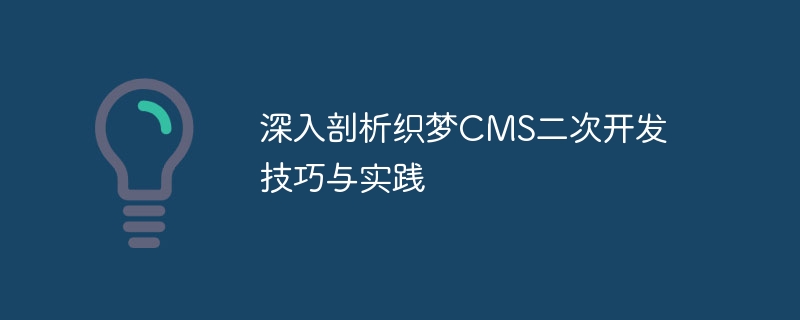

Dreamweaver CMS is a very popular open source website construction system with ease of use and flexibility, and is deeply loved by the majority of website developers and webmasters. However, sometimes we may need to carry out some customized secondary development of DreamWeaver CMS to meet specific needs or achieve specific functions. This article will provide an in-depth analysis of the secondary development skills and practices of DreamWeaver CMS, and provide you with specific code examples and practical experience.
Before carrying out the secondary development of Dreamweaver CMS, you first need to do some preparation work:
To customize the template for Dreamweaver CMS, you need to understand Weaver CMS Dream CMS template structure and tag syntax. The following is a simple example of how to add a custom template tag in Dreamweaver CMS:
// 在模板文件中添加如下标签
{dede:mytag name='custom_tag'}
// 在模板解析文件中添加如下代码
if($tag=='mytag'){
$name = isset($attlist['name']) ? $attlist['name'] : '';
$data = '这是一个自定义标签的内容';
return $data;
}To develop a custom plug-in, you need to create a plug-in directory , and write the main file and configuration file of the plug-in. The following is a simple example of how to write a simple plug-in:
// 在插件目录创建test_plugin目录,内含main.php和config.xml文件
// main.php中添加插件代码
class test_plugin{
function test(){
return '这是一个简单的插件示例';
}
}
// config.xml中添加插件配置
<plugininfo>
<name>测试插件</name>
<desc>这是一个测试插件</desc>
</plugininfo>To perform database operations, you can use the database operation class that comes with Dreamweaver CMS. Query, update, delete and other operations. The following is a simple example of how to perform database query operations:
// 使用织梦CMS数据库操作类进行查询
$article = $dsql->GetOne("SELECT * FROM `#@__article` WHERE id=1");
// 输出查询结果
echo $article['title'];Through the above specific code examples and practical experience, we can see that in the secondary operation of Dreamweaver CMS During the development process, we can perform template customization, plug-in development, and database operations according to specific needs. At the same time, continuous learning and accumulation of experience are needed to better master the secondary development skills of DreamWeaver CMS and achieve more functions and innovations.
I hope the content of this article can help everyone, so that everyone can go more smoothly on the road of secondary development of DreamWeaver CMS and realize more personalized website needs.
The above is the detailed content of An in-depth analysis of the secondary development techniques and practices of DreamWeaver CMS. For more information, please follow other related articles on the PHP Chinese website!
 What are the common secondary developments in PHP?
What are the common secondary developments in PHP?
 Which oa system is better?
Which oa system is better?
 Minimum configuration requirements for win10 system
Minimum configuration requirements for win10 system
 What's wrong with the air switch tripping?
What's wrong with the air switch tripping?
 How to set cad point style
How to set cad point style
 How to make the background transparent in ps
How to make the background transparent in ps
 How to open an account with u currency
How to open an account with u currency
 What are artificial intelligence technologies?
What are artificial intelligence technologies?




